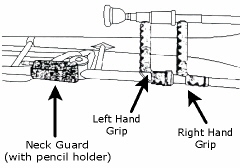Trombone Leather Hand Grips & Neck Guards Chart
The “BoneCat” Trombone Catalog
This particular page is best viewed on a PC or Mac.
| To better understand this topic, please read this top section before contacting us. |
 |
Hickey's Music stocks a large variety of leather slide grips and neckguards for many trombone makes & models. In order to make selecting the correct set easier for you, use the table below to locate your instrument and model. The table does not include options for bell color, weight or size (i.e. Bach 42B vs. Bach 42BG). If your trombone is not listed on the chart, then guards may not be available for it. We don't have measurements for many of these items, so we are unable to recommend guards for instruments not listed based on similarity of size, etc. If a leather guard is listed on the chart but not available for ordering on the site, that's because it is likely to be out of stock. See below for how to order. Please take a few moments to read through the following to better understand the situation. |
|
PLEASE NOTE: Slide Grips typically lace on with a shoestring (included). Units by Leather Specialties feature a vapor barrier that prevents moisture from reaching the surface of the instrument. So far as we know, these will not effect the sound or response of the instrument, although they will of course make your slide grips feel thicker & softer. Neck Guards for valved instruments typically use a velcro fastener to attach to the trombone. Neck guards for straight instruments typically use a lace-on design instead. See the product description and/or photo for details. This is not optional—if it uses velcro, then laces are not available and vice versa.) In addition, most neck guards have a small pencil pocket attached, allowing you to keep a short pencil on your horn for rehearsal purposes. Neckguards made by Leather Specialties feature a vapor barrier that prevents moisture from reaching the surface of the instrument. So far as we know, they will not effect the sound or response of the instrument. Delivery Time - We carry many of these grips & guards in stock, and as such they are available for immediate delivery to you. Sometimes we experience backorders from the manufacturer and might be sold out of certain models. Sold-out items have typically been taking one to three weeks to arrive to us from the manufacturer. Colors - All catalog numbers shown below are for black leather. Brown models (which use different catalog numbers) are also available, but almost every one will need to be special ordered (see Delivery Time above). How To Order - Just click on the catalog number of the item you desire and you will be taken to a page specifically for that item, where you can add it to your cart.
|
|
Leather Grips & Guards
** For instruments similar in build to Bach 50 basses. *** For instruments similar in build to Edwards & Shires basses. | |||||||||||||||||||||||||||||||||||||||||||||||||||||||||||||||||||||||||||||||||||||||||||||||||||||||||||||||||||||||||||||||||||||||||||||||||||||||||||||||||||||||||||||||||||||||||||||||||||||||||||||||||||||||||||||||||||||||||||||||||||||||||||||||||||||||||||||||||||||||||||||||||||||||||||||||||||||||||||||||||||||||||||||||||||||||||||||||||||||||||||||||||||||||||||||||||||||||||||||||||||||||||||||||||||||||||||||||||||||||||||||||||||||||||||||||||||||||||||||||||||||||||||||||||||||||||||||||||||||||||||||||||||||||||||||||||||||||||||||||||||||||||||||||||||||||||||||||||||||||||||||||||||||||||||||||||||||||||||||||||||||||||||||||||||||||||||||||||||||||||||||||||||||||||||||||||||||||||||||||||||||||||||||||||||||||||||||||||||||||||||||||||||||||||||||||||||||||||||||||||||||||||||||||||||||||||||||||||||||||||||||||||||||||||||||||||||||||||||||||||||||||||||||||||||||||||||||||||||||||||||||||||||||||||||||||||||||||||||||||||||||||||||||||||||||||||||||||||||||||
More Options
- Use our Custom Order Page to special order items you can't find.
- Use our Catalog Order Page to order items from a printed catalog, or if you already know our catalog number for the item(s) you're interested in.
- And as always, feel free to E-mail us with your questions!




















